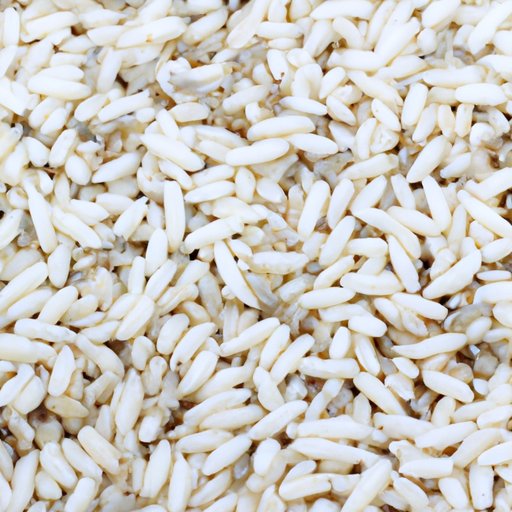I. Introduction
Rice is a staple food for millions of people around the world. Unfortunately, it is also susceptible to infestations of weevils, tiny beetles that can cause health problems and ruin stored rice. In this article, we will explore how weevils get into rice, how to prevent infestations, and how to eliminate these pesky insects from your rice supply.
II. Uninvited Guests: Understanding How Weevils Infest Rice Grains
Weevils are a type of beetle that infests stored grains, including rice. They are small, usually less than 6mm long, and have a curved appearance. Weevils have a distinctive snout-like projection on their head that they use to burrow into grains and other materials.
Weevils lay their eggs on grains like rice, wheat, and barley, and when the eggs hatch, the larvae feed on the kernels. The larvae grow into adult weevils, which emerge from the grain and mate, starting the cycle anew.
The presence of weevils in rice can have a significant negative impact. Weevil infestations can cause the rice to develop a foul odor, taste bad, and even become toxic if left unchecked for too long. Additionally, these insects can also cause health problems for humans if weevils are ingested accidentally along with the rice.
III. The Path of the Weevil: How Do They Get Into Your Rice Supply?
Weevils can enter rice supplies in many ways. Some common entry points include:
- Exposed grains: Unprotected rice grains are a perfect place for weevils to lay their eggs and make a home.
- Storage containers: If storage containers are not airtight, weevils can easily penetrate and infest the rice grains within.
- Shipping and transportation: Weevils can travel in shipping containers, trucks, and other vehicles, allowing them to spread and infect new rice supplies in different locations.
Weevils can also enter rice supplies through packaging. If the packaging is damaged or not sealed tightly enough, weevils can easily make their way inside. Once inside, they can breed and cause an infestation that can contaminate the rest of the rice.
IV. Protect Your Rice Cache: Identifying Common Entry Points for Weevils
Identifying early signs of a weevil infestation is essential to preventing the spread of these pests. The following are some tips on identifying a weevil infestation and keeping your stored rice supply safe:
- Regular Inspection: Regular inspections can help identify signs of infestations early and prevent them from getting worse.
- Storage Containers: Make sure that all storage containers used for rice are airtight and free of cracks or holes that weevils can use to infiltrate the rice. Glass, plastic, and metal storage containers are great options.
- Cleanliness: Keeping the storage area clean and free of debris and spilled rice can reduce the risk of weevil infestations.
- Sealing: Proper sealing of rice bags is essential in preventing weevil infestations. Sugars and other sweets should be kept away from rice since these attract weevils.
V. It All Starts at the Source: How Weevils Enter Rice Fields and Warehouses
Weevils can get into rice at the source, during harvesting, and storage processes. Farmers often harvest already-infested crops, providing a pathway for weevils to enter storage facilities. Storage facilities that are not properly sealed and ventilated also provide a breeding ground for weevils. Insects and diseases that exist in rice fields can also cause damage, leading to reduced crop yields, quality losses, and other problems.
To prevent weevil infestations, farmers and suppliers must take preventative measures. This may include thoroughly checking incoming shipments of rice, sealing storage areas both on and off the farm, and implementing effective disease and insect control measures.
VI. Safe Storage Strategies: Preventing Weevils from Breeding in Your Rice Supply
Storing rice properly can prevent weevil infestations. Here are some strategies to keep in mind:
- Freezing: Placing the rice in the freezer for at least four days can kill weevil eggs and prevent the spread of infestations.
- Use Herbs and Insecticides: Using herbs and insecticides can deter weevils from entering your rice supply. Herbs such as bay leaves and cloves, and insecticides such as pyrethrin, can be used to deter and kill weevils. These natural remedies leave little to no residue on rice products.
- Plastic bags: Plastic bags that are airtight can be used in place of damaged packaging to contain and prevent weevils from causing damage.
VII. Say Goodbye to Weevils in Rice: Best Practices for Eliminating and Preventing Them
Eliminating weevils can be challenging, but it is possible. Here are some practical tips for getting rid of and preventing weevil infestations:
- Freezing: This process kills the weevil eggs and larvae, making it an effective way to get rid of an infestation.
- Vacuuming: Vacuuming the storage containers and rice supply can suck up weevils and their eggs.
- Heat treatment: Rice can be subjected to heat treatment to kill weevil eggs and prevent infestations from spreading.
- Preventative measures: Preventative measures, such as regular inspections, can reduce the risk of future weevil infestations.
VIII. Conclusion
Weevils can be a frustrating and costly nuisance for rice suppliers, farmers, and consumers. By understanding how weevils enter rice supplies, how to identify early signs of infestation, and how to prevent future outbreaks, it is possible to keep stored rice safe and free from infestations.
Safe and effective storage strategies, such as freezing and proper sealing, can prevent infestations. Eliminating weevils can be challenging, but techniques like vacuuming, heat treatment, and preventative measures can be very effective.
By following the best practices outlined in this article, you can protect your rice supply from weevils and ensure that your rice is always safe to consume.
(Note: Is this article not meeting your expectations? Do you have knowledge or insights to share? Unlock new opportunities and expand your reach by joining our authors team. Click Registration to join us and share your expertise with our readers.)
